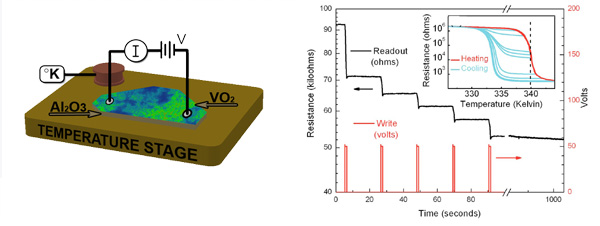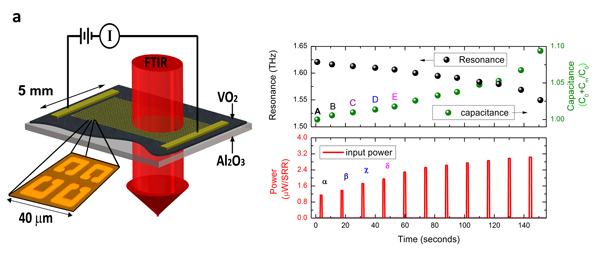/ Home / Research / Memristive systems
Memristive systems
A memristor is a nonlinear resistor whose resistance at any time depends on the "history" of voltage applied to it. Thus, the resistor remembers all past voltages, and the name memristor is a portmanteau of Memory-Resistor. The memristor was postulated theoretically in 1972 by Leon Chua (UCB), but was not conclusively demonstrated until 2008 by the group of Stan Williams (HPLabs). Research interest in the field has been fueled by postulates that memristors behave as fundamental neuromorphic circuit elements, mimicking much of the behavior of our biological neurons.
The goal of our memristor research in the Basov lab is to investigate various materials which exhibit memristive behavior, and to understand the fundamental physics that enables it. This research is a collaborative effort with Massimiliano Di Ventra, a theorist in UCSD Physics specializing in nanoscale transport and behavior.
 Phase-transition memristor
Phase-transition memristor

The 1st order phase transition in Vanadium Dioxide (VO2) exhibits a large hysteresis. Within this hysteresis loop, transient stimuli which perturb equilibrium and advance the phase transition can cause a lasting change in the state of the VO2. Here we demonstrate a VO2 device wherein short pulses of electrical voltage can cause lasting changes in the resistance of a VO2 film, effectively storing information in the film. This information can then be read-out using small voltages, which will not further alter the VO2. This observed behavior is best described as a "symmetric current-driven memristive system".
 Memory capacitance
Memory capacitance
It has been recently postulated that the same nanoscale effects which can lead to memory-resistance in materials may also lead to memory-capacitance and memory-inductance (Di Ventra et.al.).
In vanadium dioxide, the percolative nature of the phase-transition leads to a inhomogeneous mixture of insulating and metallic domains on a nanoscale. This inhomogeneity results in dramatic changes in the dielectric constant of VO2 as it passes through a small critical section of it's phase-transition. To probe this dielectric constant, we fabricated a Split-Ring-Resonator (SRR) metamaterial on top of a VO2 film. The SRR's form microscale capacitor plates which are sensitive to the dielectric of VO2. The capacitance of these SRR's can then be read out spectroscopically using THz light.
We observe the capacitance of the combined VO2+SRR system responds to transient electrical current pulses in nearly the same way as our VO2-memristor. Short pulses modify the capacitance, with the system exhibiting a 'memory' of these events.

VO2+SRR Hybrid metamaterial which exhibits memory-capacitance. Short electrical pulses modify the dielectric of the VO2. These dielectric changes alter the capacitance of each SRR in the metamaterial, which is reflected spectroscopically in the THz resonance feature. This memory-capacitance effect also has an interesting application within the field of metamaterials, as it manifests as persistent tuning of the metamaterial.
Recent publications:
Driscoll, T., et al. Memory Metamaterials. Science 2009 315,1518 PDF
Driscoll, T., et al. Phase-transition driven memristive system. Applied Physics Letters, 2009 95,043503 PDF